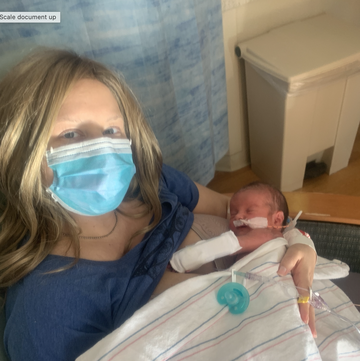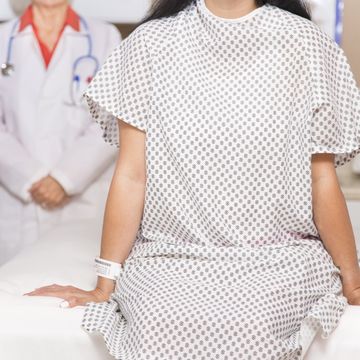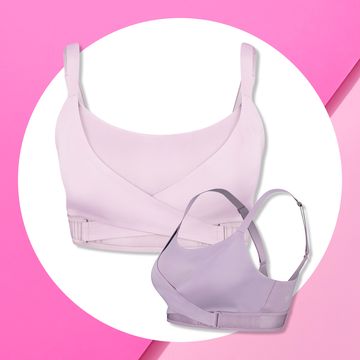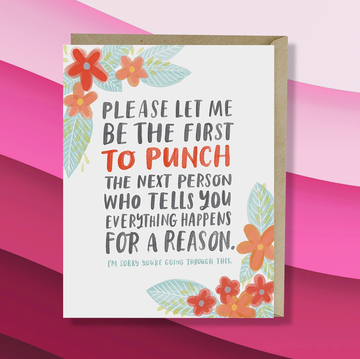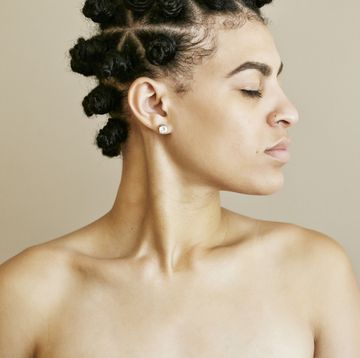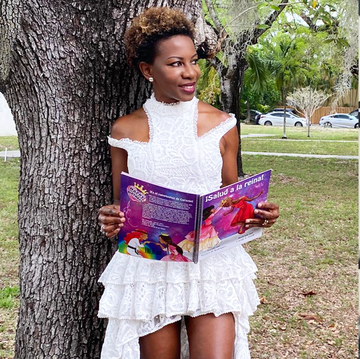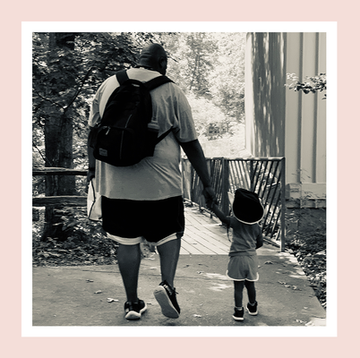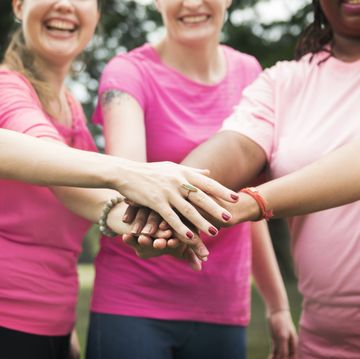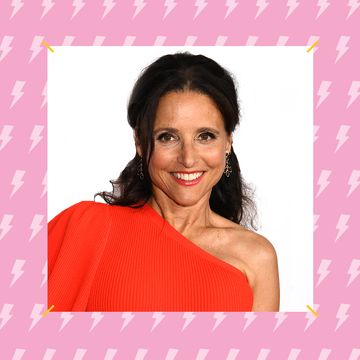WomensHealthMag.com originally published this story in October 2014 and republished it October 1, 2015, to coincide with National Breast Cancer Awareness Month.
Kate Petrides never used to give National Breast Cancer Awareness Month much thought. “It wasn't really my issue,” says the 27-year-old, who works in the human resources department for a nonprofit in New York. “I was young, and usually you associate breast cancer with older women. My grandmother on my father's side had had breast cancer, but other than that, I didn't really have any connection to the disease.”
Then, in July of 2012, when she was 25, Kate was diagnosed with the disease. She had to cancel her plans to move to Spain to teach English; instead, she enrolled in a clinical trial and started undergoing chemotherapy.
If you’ve never had breast cancer or been close to someone who’s dealt with it, you might expect people with the disease to welcome October with open arms—but that wasn’t quite in line with Kate’s experience.
“I didn’t find it especially supportive,” she says. “It draws a lot of awareness to a particularly sensitive time in your life—and the emphasis isn't quite where I'd like it to be.”
Many breast-health advocates agree that the efforts tied to National Breast Cancer Awareness Month are often misguided—and could even be causing a variety of problems.
“Initially, the argument was the pink ribbon will help bring awareness to breast cancer,” says Karuna Jaggar, executive director of Breast Cancer Action, which launched its Think Before You Pink campaign this year. “Here we are, 20-some years after 1991, when Self magazine and Estee Lauder launched the first [National Breast Cancer Awareness Month], and 40,000 women continue to die each and every year. We just have not seen the improvements in the breast cancer field that we would have liked to see. … The question we have to ask is, ‘What do we have to show for it?’”
The Danger of Pink Ribbon Products
Chances are, you’ve heard of the term “pink washing." When Breast Cancer Action coined it in 2003, it referred specifically to products for which a percentage of the profits are given to a breast cancer-related charity—even though that item contained something that research has linked to increased odds of getting breast cancer (a company selling water bottles that contain BPA might fall into this category, for example).
RELATED: 4 Ways to Lower Your Environmental Breast Cancer Risk
Now, the term is used more broadly to refer to any company that profits from breast cancer in some way—often while making misleading claims about how much consumers’ purchases will actually benefit breast cancer-related charities.
“Anybody can put a pink ribbon on anything, and they do,” says Jaggar. “We’ve seen pink ribbon handguns, alcohols, cosmetics. You name it, somebody has put a pink ribbon on it.”
The money pouring in from sales of these products—as well as how much is actually being donated, where it’s going, and how it’s being spent—is still a concern. (Check out four questions to ask yourself before you buy a pink ribbon product to make informed decisions when buying these items.) Even so, experts say focusing on pink ribbon purchases during the month of October poses another sinister problem: More often than not, these products fail to provide any real education or effect changes in women’s health behaviors.
“It's a heck of a lot easier for a brand to slap a pink ribbon on something, donate a percent of their proceeds, and call it a day,” says Lindsay Avner, founder and CEO of Bright Pink, a national non-profit dedicated to saving women's lives from breast and ovarian cancer by empowering them to be proactive at a young age. “It's much harder to break down complicated health information.” Similarly, buying a pink product allows consumers to feel like they’ve “helped” the cause of breast cancer patients—even if they haven’t learned anything about what their odds of developing the disease are or what they should do if they receive a diagnosis.
RELATED: What It’s Like to Get a Double Mastectomy
“If they buy that product, they're able to mentally go, ‘Check. I did breast cancer already,’” says Avner. “But that same woman, maybe she hasn't gone to the gynecologist in over a year and a half and doesn't realize she needs to be going once a year. … She's almost making it someone else's problem instead of making it her own.”
For Your Misinformation
Even efforts that are actually aimed at spreading health information can miss the mark. Take, for example, the NFL’s A Crucial Catch campaign. If you’ve watched a football game this month, then you’ve surely seen all of the pink on the field and watched the commercial featuring a woman named Lisa who was diagnosed with breast cancer when she was 40. “It’s because of this first mammogram that I’m able to enjoy time with my children and my family,” she says in the commercial. “Get an annual mammogram.” There’s only one problem: Not all experts actually recommend annual mammograms as the primary line of defense for detecting breast cancer in women 40 to 49.
While some health organizations still suggest women in that age range get a mammogram each year, there’s currently no scientific evidence that these screenings have any effect on mortality. Some medical professionals also argue that, since healthy breast tissue is more likely to look like it could be cancer on mammograms for women 40 to 49, these screenings result in unnecessary stress for patients—not to mention additional testing that can be nerve-wracking and expensive.
RELATED: Breast Cancer FAQs
This is just one example of what experts say is a dangerous disregard for the current body of knowledge surrounding the realities of breast cancer and detection of the disease.
“In some of the media, what you tend to see is a dumbing down in a sense,” says Gayle Sulik, Ph.D., founder and executive director of Breast Cancer Consortium.
“It's hard to talk about cancer; it’s very, very complicated. And so when you connect it to a campaign and want to have a headline, sometimes really important details get lost.”
A survey from Bright Pink, for example, shows that two-thirds of women would be more likely to make lifestyle changes to prevent breast and ovarian cancer if they knew more about ways to reduce their risk—but just more than half of the women surveyed were familiar with ways they could lower their odds of breast and ovarian cancer.
RELATED: 10 Ways to Lower Your Risk of Breast Cancer
Since so much coverage in the media and in “awareness”-related campaigns focus on emotional appeals and individual breast cancer patients’ anecdotes—rather than science-based information about the disease—experts say the result is often fear mongering that perpetuates misunderstandings about breast cancer.
“You have companies that sell pink ribbon products, and to do this they have to sell a story,” says Jaggar. “A story that manipulates people's emotions to make them feel they must urgently donate.”
Studies show, for example, that only about 10 percent of women correctly estimate their breast cancer risk (one in eight women will be diagnosed with breast cancer in her lifetime). This kind of misunderstanding about the nature of breast cancer can become even more harmful when a woman is diagnosed with the disease.
“The evidence is very clear that in women of average risk [without a faulty BRCA1 gene], if those women are diagnosed with breast cancer and they choose to have a double mastectomy, they're no less likely to die than women who don't have that surgery,” says Jaggar. “[The point of bringing this up is] not to judge women's choices, but the rate of that surgery is going up 15 percent a year. Why are these choices skyrocketing, despite the medical evidence? A lot of experts are concerned that so many of these pink ribbon campaigns are fueling fear in a way that makes it very hard for women to follow the evidence if and when they get a breast cancer diagnosis.”
How the Pink Ribbon Movement Obscures the Reality of its Cause
There’s another compelling argument against putting so much attention on the pink ribbon come October: It can alienate the people who actually have breast cancer.
After 18 months of chemotherapy, radiation, and surgery, Kate is free of any signs of cancer and takes a maintenance hormone therapy drug to reduce her odds of the disease returning—but you won’t hear her call herself a “survivor.”
“There's a misconception that once you're done with treatment, you're cured,” says Kate.
While three fourths of breast cancers will be cured, it’s impossible to know which cancers might recur—and when breast cancer comes back, it is usually more deadly than on its first occurrence. “Breast cancer awareness puts a lot of emphasis on the people who are ‘survivors,’ so women with metastatic disease are sort of left out of that rosy picture,” says Kate. “It doesn't fit the mold that I guess people want to focus on. They want to put the message out there that we can beat this and everything's happy, but it doesn't really show the reality of the disease.”
“As more people have been diagnosed with breast cancer, they see the disconnect [between the breast cancer awareness messaging] because they're living it,” says Sulik. “Breast cancer is not just one disease, and early detection doesn't cut it. … We want to get the diversity of stories out because there's been so much of a focus over the years about heroically beating breast cancer, and there are too many people who don't beat it. There are too many people who may still be alive and living with it but are certainly not cured, so I think that stuff has to get out, as well.”
Fixing the Pink Ribbon Problem
Kate says she’s grateful that she was diagnosed with a disease that gets so much attention—but that she thinks the conversation around breast cancer awareness needs to shift. Many breast health advocates agree.
For companies that want to do something to further the cause, this means spreading genuinely useful information that can help women increase their understanding of the disease and effect meaningful changes in their own health behaviors. SoulCycle, for example, is offering complimentary shower hangers this month that provide step-by-step instructions on how to do a self-breast exam. (It’s worth noting that some experts no longer recommend doing monthly self-breast exams—but that the more familiar you are with your breasts, the more likely you are to notice potentially dangerous changes.)
“It needs to be more focused on the science and the evidence and trying to get information out in a way that is understandable so that people can start to think about, ‘What does it really mean to be at risk for breast cancer? How do I know if I am at risk? How do I know if I should worry about genetic testing or not?’” says Sulik. “Those types of things are complex and need to be addressed if we're going to deepen awareness.”
On an individual level, this means purchasing pink products responsibly and also making sure you’re informed about the reality of breast cancer—and what you can do to stay healthy and increase your odds of early detection.
“We shouldn't scare women and pressure them, but we should make being proactive so inviting and so positive and something they feel like they're loved and supported throughout,” says Avner, whose organization Bright Pink offers resources such as an Assess Your Risk Tool, monthly text message breast health reminders, plus information about early detection and steps women can take to decrease their odds of getting breast cancer.
“I think what it revolves around is not taking the pedal off the gas around the cause [of breast cancer awareness], but changing the message and realizing this is not something that happens the first two weeks in October,” says Avner. “This is the reality that happens for women every single day of the year.”
NOTE: WomensHealthMag.com reached out to both the National Breast Cancer Foundation and Susan G. Komen for comment but didn’t receive responses from either organization.
Robin Hilmantel is the digital director at Women's Health, where she oversees the editorial strategy for WomensHealthMag.com and its social platforms. She has almost 10 years of experience writing and editing for national publications, and more than 8 years of experience writing and editing health, fitness, and nutrition content specifically. In addition to Women's Health, her work has also appeared in TIME, Food Network Magazine, Cosmopolitan, New York Magazine, SELF, Glamour.com and other publications.
